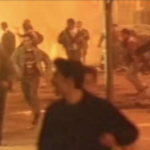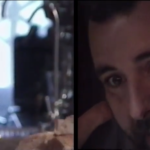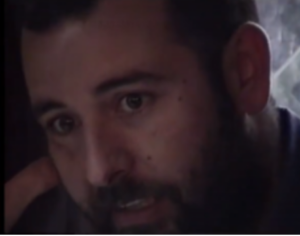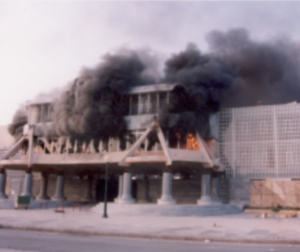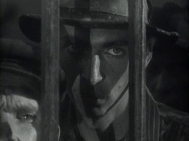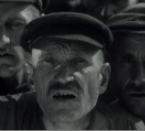Luis López Carrasco (V.O.)
Film as counter-information
Having premiered in the Tiger Competition at the 2020 Rotterdam International Film Festival, El año del descubrimiento / The Year of Discovery is Spanish filmmaker Luis López Carrasco’s second feature film. A playful documentary which blurs temporalities and plays with the possibilities of the VHS medium itself – inviting comparisons with Carrasco’s first feature El futuro –, the film provides an in-depth examination of a gone era. The film moves swiftly through the Spanish social landscape: an entire history of political struggle and leftism takes shape in front of our eyes, recalled by those who, over the ages, transformed these abstractions into concrete realities and took it to the street to shout their discontent. Deploying its stories for over 3 hours, the film sets out to reignite the flame of collective utopias, of better alternatives past and future, of social involvement and street negotiations, at a time when the global political struggle seems to have reached a point of exhaustion.
Débordements : You were born in Murcia – one of the regions documented in your film – in 1981. As you were growing up, did you have a clear feeling of the social tensions and the political struggle that were rising to the surface at that time, and which led to the 1992 street protests?
Luis López Carrasco : Just to make things a little bit more clear: Murcia is a region in the south-east of Spain. The capital city of the region is also called Murcia. The second city which is the focus of the movie – the harbour – is Cartagena. The point is that, while all the administrative power is concentrated in the capital – Murcia – the regional government decided to build the parliament in Cartagena, so as to make this place an important part of the regional politics. This is, roughly put, the configuration of that territory.
As for my intuitions regarding the social tensions of that era – nothing of that sort. I only used to go to Cartagena to visit my grandparents – my grandfather used to work in a bank and my parents were doctors. They were really young at that time. There are several intertwining aspects to this story: we lived in the capital, and my feeling is that usually, people from the capital are not really aware of what is going on in the periphery. So Cartagena people are always complaining that they don’t get the attention they deserve. In a way, that’s true, were I to think about myself. But it was also a matter of social class, mind you: I can say that I come from an educated, middle-class family – and middle-class people are often unaware of the working class. I myself went to a public school and most of my friends were sons of workers. Though there is no stable industry in Murcia and most of the workers come from the construction branch. At the same time, back then I was a kid – but I remember, being 11 and watching on TV the burning parliament. And when I once asked my family what happened at that moment in time, they could not remember – so that is the reason why I made the film.
D. : Talking about motivations: the movie resumes, in an encompassing cinematographic gesture, a whole history of leftism and social dynamics in Murcia in particular, and in Spain in general, since it moves back and forth in time, from the Civil War to present day. At the same time, lots of social segments intersect in your movie – from factory workers to students to nostalgic people of the Franco regime. How did you settle for this large scope, and where does this ambition to “state it all” come from?
L.L.C. : My first feature film El futuro (2014) was also a kind of home movie – a re-enactment set in an apartment in 1982. At the beginning, we were planning to do it that way for this film, as well. But then it became more important to actually portrait the people of the riots and of the present moment. Eventually, the film started to grow after we began meeting people who wanted to tell us their story. Me and my screenwriter, the son of a shipyard worker from Cartagena, we would have some beers with friends, someone would talk about something and we would be like “hey, that should be in the movie !” Initially, we only did interviews with those who took part in the 1992 events. But gradually, the film became a collective portrait going back to the end of the Civil War. And this was a problem, because we never knew where to stop – one week before the end of our production schedule, we would still add people in the film. We wanted to expand in all directions. For example, the Navy is very strong in Cartagena, so we naturally wanted to include them in the film – but in the end they could not appear, because the army would not let them. All in all, it was a difficult process, which initially was supposed to lead to a 5-hour movie. Some of the parts related to the dictatorship were initially longer.
But the main point was allowing people to talk – maybe for the first time – about work and working class neighbourhoods, and then start to reflect on political and social changes over time, and how these workers position themselves now regarding unions, globalization, working conditions. The events of 1992 – a victory and a defeat at the same time – was the starting point of all this. Probably what happened at that precise moment led to the present situation.
D. : It is as if your movie decided to tell the backstage story of those years: officially, what the television footage of those years tells us is that the social progress in Spain was undeniable – the Barcelona Olympics, the integration in the European Economic Community, etc. Yet at the same time people were losing their jobs and were taking it to the streets.
L.L.C. : I started to think about this film as I was meeting my schoolmates during Christmas anniversary dinners – they would tell me about their childhood and the difficult working conditions nowadays. This film is also a means of recovering my own memories. It is part of a personal project as well, related to my own biography – there is an echo of the working class neighbourhood where I lived in Madrid, for example. Also, my wife’s family is from the North and most of the stories appearing in the film are connected to it. My main objective when doing this film was to go against the official stories that were being told in Spain at that time: Spanish society thought of itself as wealthy; people started making films exclusively about middle-class issues, urban comedies – it was connected to certain laws promoting certain kinds of films… Concretely speaking, from 1983 to 1999 there are almost no documentaries at all – as if cinema did not need to connect or portrait different realities anymore, compared to the seventies, which were much more political times. So when this social crisis arrived to Spain, most of my friends had to leave the country; I had the feeling that the country where I was raised had disappeared. Which meant that I could not understand the present – I did not know how to live in this new country. We, the people of my age, thought its structure was strong, while in reality it was very weak – we were so lost and confused, that I, for example, started to make films about the past in order to try and understand the present. I guess a lot of people were living in a sort of self-made lie back in the day – because cinema and television would leave out important social groups still living in the country; these groups of dispossessed people simply disappeared from the cultural texts of the period.
D. : Yet your film – and his predecessor El futuro – could also be taken as a collection of human gestures which belong to a certain era. You dwell on facial expressions, verbal tics, people chatting or smoking. Judging from what we see, you seem to be somehow endorsing Godard’s claim that a John Ford western should also be considered a documentary about John Wayne and the other actors on set. Are you interested in something like that ?
L.L.C. : I think that is the way I am – and that is the way I see people. Most of the people who appeared in El Futuro and some of those who appeared in El año del descubrimiento are friends. I tried to get close to them. At one point in my life I became tired of films without dialogues, which instead employed long general shots. I liked this kind of approach up to 2005, but from then onwards I had the feeling that what I need to capture is the way people interact with one another. Because that is the life I live – those are the connections and relations that surrounded me. So I decided that these films had to be full of human life – full of those lively experiences. As for the close-up shots – Frederick Wiseman and Eduardo Coutinho were my main references for this film. I hope that, in 200 years time, we will consider these filmmakers as really important – maybe their films did not use very sophisticated devices, but they were like a museum dedicated to human kind. So I felt that I had to avoid film concepts or more aesthetical approaches towards my material. Now of course, every aesthetics depends on the film I’m doing, but with every new film I try to forget more and more about the formal device and instead get to know people closely. I also write short stories – everything I can achieve with my imagination is going to be in a short story. So if I still make films, it is to gather people that I don’t know, because during the shooting I can create the conditions for the unexpected to happen. In this interaction of people in a certain given space something could appear that my imagination was unable to create. For me, it is very important that cinema be a material art. I think that the material aspects – bodies, objects, concrete spaces – had to be in this film.
D. : You seem to be valorising film form in a negative fashion. Yet your films have a very advanced conception about the limits of representation. Unlike Godard’s political body of work, for example, which aims to break the illusion, you are interested in creating a hypnotic illusion of realism, an immersion into a different time and space, a recuperation of a gone era and of its textures. You seem to be saying: the medium is the message.
L.L.C. : That’s interesting. However, I don’t believe in Godard’s idea that a political film has to be a politically made film. I am not sure that the form is intrinsically related to politics. Of course, there are a lot of articles on the matter – for instance Laura Mulvey believes that, in order for a film to be truly political, its formal structure cannot reproduce the normative and orthodox approaches of the industry. I used to think that myself – for example, I hated Michael Moore’s documentaries. But then I realized I did not hate them because they were edited like TV shows, but because their ideas were much too simple. So I’m starting to reject this theoretical doxa – because you, as an author, cannot control the film’s message: maybe your films are political, but that judgment is in the eye of the spectator. That is why I did not want that the aesthetical approach for this film, which is about collective memory, to be imposed on the storytelling. I tried to make this film available to many audiences. There is no empirical demonstration that a very modernist deconstruction of the film would generate a certain political point of view. I am not saying that it is impossible – but I do not think that it necessarily has to be done only that way. Open-minded, critical judgments about our world should be proposed in many forms.
D. : But since your first movie, which focused a lot on a certain atmosphere, a certain zeitgeist of an era, you literally seem to have found a second screen – you get the atmosphere of a bar, but you also get the people’s angry, or nostalgic, or resigned voices.
L.L.C. : We decided to employ the split screens in the first phase of the editing process. I was already sure that – as the film is only based in the cafeteria, except for the original footage of the riots – there were only going to be close shots of the people talking. However with the second screen, I tried to make the space expand. Me and my editor had the feeling that the experience of being in a cafeteria – drinking, listening to different dialogues – which is to say, the experience of a certain space, surrounded you better with these two screens. This choice also worked in favour of not imposing a central focus of the screen – your eye can wander and chose for itself, your sight is free. At the same time, I like the idea that even when people are alone in their screen, somehow they are accompanied by people in the other screen – alone and connected to a collective space simultaneously. It is also related to choosing a cafeteria for the film – a private place which also has a semi-public atmosphere to it. Sometimes, people in a cafeteria can discover an area of intimacy with those working there.
D. : The movie ends with someone recounting two dreams – a daytime one, as in “aspiration”, and a night time one, as in “nightmare”. You seem to dwell quite a lot on this double meaning, as if you wanted to give back some desire for a social utopia.
L.L.C. : At the beginning we only focused on economic and material aspects of the lives of those we were interviewing. But then we thought that asking people to talk about their dreams could tell us a lot about their inner motivations and inner fears. I asked every person in the film about their dreams – and this confusion between the two meanings came from them: we would ask them about their night time dreams, but all the time they would talk about hopes. In Spanish, “ilusión” has the double meaning of “hope” and “mirage”.
The film is full of desolation and confusion. The dreams recounted in the film worked in different ways. If I decided that the last dream was about a man’s desire to fight the Nazis, so people would not forget him, it was because for me it was an important statement – one that is related to a situation where the worker is not able to punch back anyone, anymore. This impotency appears both in dreams and in reality. So I don’t necessarily think that the approach is utopic, but I sure did not want to produce a hopeless film.
D. : It seems to me that the film arrives on the big screen at a moment when, as one character puts it, politics are concentrated to the right and threaten to slip to the far right. On a global level, we are experiencing a moment of exhaustion of the political struggle. At a certain point, one character points out that we don’t take it to the street to express our anger anymore. Did you conceive this film as a political tool as well?
L.L.C. : Profit Motive and the Whispering Wind, a film by John Gianvito, starts with a quote from Claire Spark Loeb, which says: “The long memory is the most radical idea in America.” The main point is that, in Murcia, a lot of aspects related to social utopias were completely abandoned and forgotten because of dictatorship and, later on, because of the media politics. The idea of looking back and bringing back this collective memory is crucial – because history, in a certain way, is always critical of the official institutions and of reactionary movements. For the crew and for some of the characters, this film was also a process of awakening consciousness. Many people make use of prejudices and stereotypes because the information is more or less controlled and concentrated in certain spaces. But if you are able to liberate and put that information in motion – and construct your film as counter-information – I think this could give you the necessary tools to reflect on the present state of things and on how to change it.


